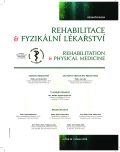The Involvement of the Amadeo Instrument into a Standard Therapy in Patiens after Brain Vascular Event in the Chronic Phase: A Follow up Study
Authors:
A. Oktábcová; J. Uhlířová; A. Čábelková
Authors‘ workplace:
Klinika rehabilitačního lékařství 1. LF UK a Všeobecné fakultní nemocnice v Praze, přednostka doc. MUDr. O. Švestková, Ph. D.
Published in:
Rehabil. fyz. Lék., 24, 2017, No. 1, pp. 23-28.
Category:
Original Papers
Overview
Over the last years the numbers of individuals surviving brain vascular events causing limited motor activities leading to sensory and cognitive disorders have been gradually increasing. It resulted in decreased abilities to perform common daily activities and involvement in social and community activities. An improvement of upper extremity functions is a complex process and requires a multidisciplinary approach, which is used for obtaining maximum independence and maximum possible self-reliance.
The use of novel robotic techniques developed over the last ten years provides the perspective of improving results of rehabilitation, as they proved useful for increasing the motor activity output. One of the robotic instruments for hand rehabilitation if Amadeo based on terminal effecter without exoskeleton; it makes possible a functional motion therapy of fingers and motivation feedback. It provides a passive, assisted therapy as well as the interactive treatment.
The objective o this follow up study was to prove sustainable improved functions after a month of intensive treatment on the Amadeo instrument and even a month after the therapy ended. The investigated or influenced functions included extent of the movements, muscular grip strength and motor functions of the hand. Twelve patients in the chronic phase after brain vascular events were enrolled in the study. The improvement and sustainability was tested by the standardized test for maintaining motor functions of upper extremity (Jebsen Taylor Hand Function test), hand grip strength (Jamar Dynamometer), motion range of fingers (Goniometry) before and after a series of treatments (one month, three times weekly) and then again after a month since the intensive treatment ended.
Unfortunately, any demonstrable influence on improvement of the fingers’ motion range, muscular strength of fingers and hand functionality was not proved. However, subjective opinions of the study participants in the robotic assisted hand treatment of patients in the chronic phase after brain vascular event can be summarized: it has become apparent as an explicitly visualized motivation feedback, which was evaluated very positively bz the patients.
Keywords:
Amadeo, robotic assisted treatment, brain vascular event, follow up study
Sources
1. BALASUBRAMANIAN, S., KLEIN, J.,BURDET, E.: Robot-assisted rehabilitation of hand function. Current Opinionin Neurology. 2010, 23(6), 661–670. DOI: 10.1097/WCO.0b013e32833e99a4. ISBN 10.1097/WCO.0b013e32833e99a4. Dostupné také z: http://content.wkhealth.com/linkback/openurl?sid=WKPTLP:landingpage
2. Hospitalizovaní a zemřelí na cévní nemoci mozku v ČR v letech 2003–2010. In: Ústav zdravotnických informací a statistiky ČR. [online]. 2012 [cit. 2015-10-05]. Dostupné z: www.uzis.cz/system/files/03_12.pdf.
3. HWANG, C. H., SEONG, J. W., SON, D. S.: Individual finger synchronized robot-assisted hand rehabilitation in subacute to chronic stroke: a prospective randomized clinical trial of efficacy. Clinical Rehabilitation, 26, 2012, 8, s. 696-704. DOI: 10.1177/0269215511431473. ISSN 0269-2155. Dostupné také z: http://cre.sagepub.com/cgi/doi/10.1177/0269215511431473.
4. PFEIFFER, J.: Neurologie v rehabilitaci: pro studium a praxi. 1. vyd., Praha, Grada, 2007, 351 s. ISBN 978-80-247-1135-5.
5. SALE, P., FRANCESCHINI M., MAZZOLENI, S., PALMA, E., AGOSTI, M., POSTERARO, F.: Effects of upper limb robot-assisted therapy on motor recovery in subacute stroke patients. Journal of NeuroEngineering and Rehabilitation [online]. 2014, 11(1), 104- [cit. 2016-02-14]. DOI: 10.1186/1743-0003-11-104. ISSN 1743-0003. Dostupné z: http://www.jneuroengrehab.com/content/11/1/104.
6. SALE, P., MAZZOLENI, S., LOMBARDI, V., GALAFATE, D., MASSIMIANI, M. P., POSTERARO, F., DAMIANI, C., FRANCESCHINI, M.: Recovery of hand function with robot-assisted therapy in acute stroke patients: Feasibility and Preliminary Results of a Robotic Treatment in Patients with Hemiparesis. International Journal of Rehabilitation Research. 2014, 37(3): 236-242. DOI: 10.1097/MRR.0000000000000059. ISSN 0342-5282. Dostupné také z: http://content.wkhealth.com/linkback/openurl?sid=WKPTLP:landingpage
7. STEIN, J., BISHOP, L., GILLEN, G., HELBOK, R.: Robot-assisted exercise for hand weakness after stroke. American Journal of Physical Medicine & Rehabilitation [online]. 2011, 1- [cit. 2016-04-03]. DOI: 10.1097/PHM.0b013e3182328623. ISSN 0894-9115. Dostupné z: http://content.wkhealth.com/linkback/openurl?sid=WKPTLP:landingpage&an=00002060-900000000-99684
Labels
Physiotherapist, university degree Rehabilitation Sports medicineArticle was published in
Rehabilitation & Physical Medicine

2017 Issue 1
Most read in this issue
- Robotic Rehabilitation of the Hand Spasticity
- Electrostimulation as an Effective Tool in Therapy of Vocal Cords
- Prop Up Movement Patterns and their Effect on Patients after Total Hip Replacement
- A Photomechanic Effect of High-Intensity Laser of Class 4 1064nm on the Pain Transfer Via Free Nerve Endings: a Multi-Centric, Randomized, Placebo-Controlled Study
